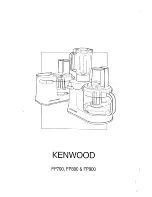
INSTRUCTION FORMATS
MOTOROLA
INSTRUCTION SET INTRODUCTION
6 - 9
the user condition code register (CCR) occupying the low-order eight bits. The SR may
be accessed as a word operand.
The MR and CCR may be accessed individually as word operands (see Figure 6-6(b)).
The LC, LA, system stack high (SSH), and system stack low (SSL) registers are 16 bits
wide and may be accessed as word operands (see Figure 6-6(a)). When used as a source
operand, these registers occupy the low-order portion of the 24-bit word; the high-order
portion is zero. When used as a destination operand, they receive the low-order portion
of the 24-bit word; the high-order portion is not used. The system stack pointer (SP) is a
6-bit register that may be accessed as a word operand
.
The PC, a special 16-bit-wide program control register, is always referenced implicitly as
a short-word operand.
6.3.3 Data Organization in Memory
The 24-bit program memory can store both 24-bit instruction words and instruction exten-
sion words. The 32-bit system stack (SS) can store the concatenated PC and SR registers
(PC:SR) for subroutine calls, interrupts, and program looping. The SS also supports the
concatenated LA and LC registers (LA:LC) for program looping. The 24-bit-wide X and Y
memories can store word, short-word, and byte operands. Short-word and byte operands,
which usually occupy the low-order portion of the X or Y memory word, are either zero
extended or sign extended on the XDB or YDB.
The symbols used to abbreviate the various operands and operations in each instruction
and their respective meanings are shown in the following list:
Data ALU
Xn
Input Registers X1, X0 (24 Bits)
Yn
Input Registers Y1, Y0 (24 Bits)
An
Accumulator Registers A2 (8 Bits), A1, A0 (24 Bits)
Bn
Accumulator Registers B2 (8 Bits), B1, B0 (24 Bits)
X
Input Register X (X1:X0, 48 Bits)
Y
Input Register Y (Y1:Y0, 48 Bits)
A
Accumulator A (A2:A1:A0, 56 Bits)
*
B
Accumulator B (B2:B1:B0, 56 Bits)
*
AB
Accumulators A and B (A1:B1, 48 Bits)
*
*Data Move Operations: when specified as a source operand, shifting and limiting
are performed. When specified as a destination operand, sign extension and zero
filling are performed.
Summary of Contents for DSP56K
Page 12: ...xii LIST of TABLES MOTOROLA List of Tables Continued Table Page Number Title Number ...
Page 13: ...MOTOROLA DSP56K FAMILY INTRODUCTION 1 1 SECTION 1 DSP56K FAMILY INTRODUCTION ...
Page 31: ...MOTOROLA DATA ARITHMETIC LOGIC UNIT 3 1 SECTION 3 DATA ARITHMETIC LOGIC UNIT ...
Page 50: ...DATA ALU SUMMARY 3 20 DATA ARITHMETIC LOGIC UNIT MOTOROLA ...
Page 51: ...MOTOROLA ADDRESS GENERATION UNIT 4 1 SECTION 4 ADDRESS GENERATION UNIT ...
Page 77: ...MOTOROLA PROGRAM CONTROL UNIT 5 1 SECTION 5 PROGRAM CONTROL UNIT ...
Page 124: ...INSTRUCTION GROUPS 6 30 INSTRUCTION SET INTRODUCTION MOTOROLA ...
Page 125: ...MOTOROLA PROCESSING STATES 7 1 SECTION 7 PROCESSING STATES STOP WAIT EXCEPTION NORMAL RESET ...
Page 167: ...STOP PROCESSING STATE MOTOROLA PROCESSING STATES 7 43 ...
Page 168: ...STOP PROCESSING STATE 7 44 PROCESSING STATES MOTOROLA ...
Page 169: ...MOTOROLA PORT A 8 1 SECTION 8 PORT A ...
Page 176: ...PORT A INTERFACE 8 8 PORT A MOTOROLA ...
Page 177: ...MOTOROLA PLL CLOCK OSCILLATOR 9 1 SECTION 9 PLL CLOCK OSCILLATOR x x d Φ VCO ...
Page 191: ...10 2 ON CHIP EMULATION OnCE MOTOROLA SECTION 10 ON CHIP EMULATION OnCE ...
Page 218: ...USING THE OnCE MOTOROLA ON CHIP EMULATION OnCE 10 29 ...
Page 604: ...INSTRUCTION ENCODING A 338 INSTRUCTION SET DETAILS MOTOROLA ...
Page 605: ...MOTOROLA BENCHMARK PROGRAMS B 1 APPENDIX B BENCHMARK PROGRAMS T T T T T P1 P3 P2 P4 T T T ...
Page 609: ...BENCHMARK PROGRAMS MOTOROLA BENCHMARK PROGRAMS B 5 ...
Page 611: ...BENCHMARK PROGRAMS MOTOROLA BENCHMARK PROGRAMS B 7 ...
Page 613: ...BENCHMARK PROGRAMS MOTOROLA BENCHMARK PROGRAMS B 9 ...
Page 615: ...BENCHMARK PROGRAMS MOTOROLA BENCHMARK PROGRAMS B 11 ...
















































